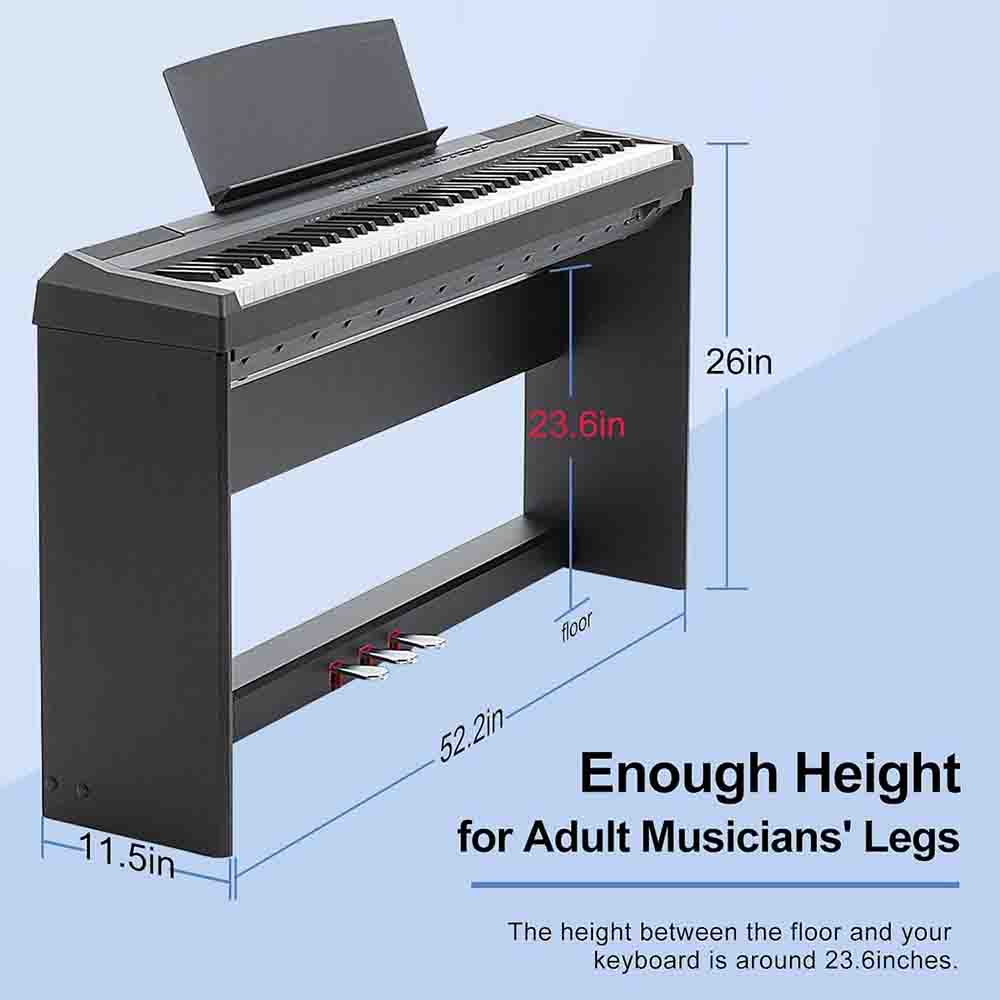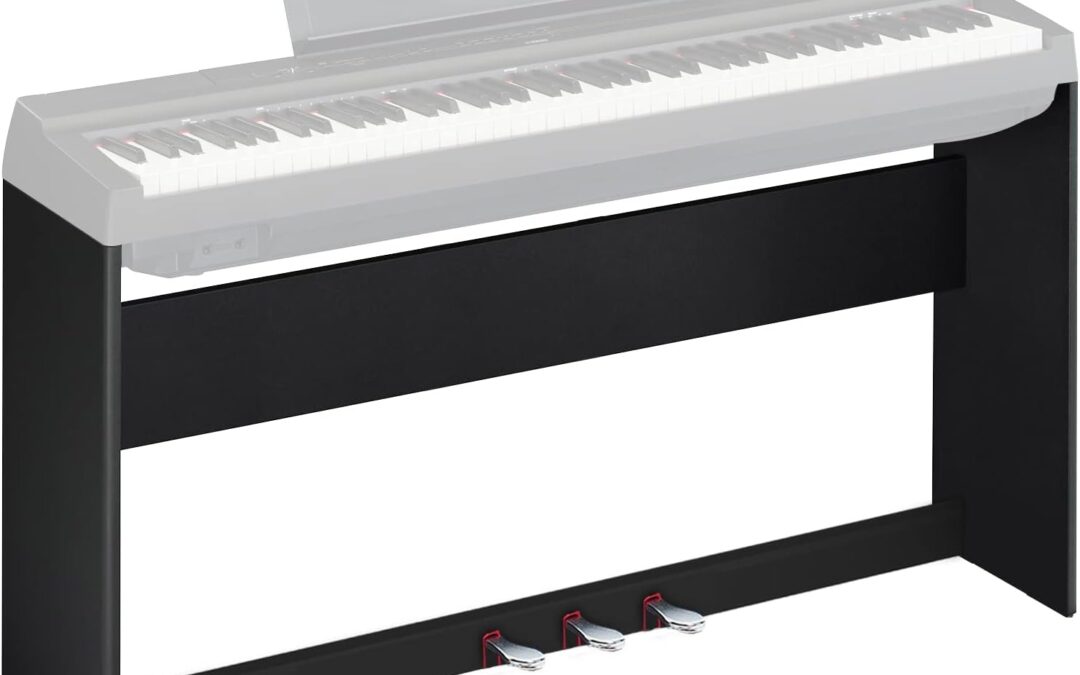YAMAHA P125 REVIEW
In April 2018, Yamaha, a renowned Japanese manufacturer, unveiled the new P-125 digital piano as an upgrade to its predecessor, the P-115. Positioned as the new midrange keyboard in the P (Portable) series, the Yamaha P-125 quickly gained popularity among musicians. The release of a new model implies that Yamaha has introduced exciting features and enhancements, as they wouldn’t simply rebrand an old model as new.
The Yamaha P125 offers a user-friendly experience
One notable aspect of the Yamaha P125 is its remarkable ease of use. Despite being a technologically advanced instrument, it manages to simplify complex features, making it accessible even to beginners. While some digital pianos can be daunting for newcomers, the P125 strikes a balance by catering to professionals while remaining user-friendly for beginners.
One notable difference is the absence of an LCD screen. Although some may consider this a drawback, the P125’s clean design compensates for it. Navigating the menu is surprisingly easy, even without a screen.
Volume control is conveniently located on the top left side of the dashboard, allowing for quick adjustments. Additionally, the P125 is equipped with two headphone jacks, offering added convenience. This feature proves beneficial when practicing without disturbing others, and both you and your teacher can utilize the headphone jacks simultaneously.


Specification
The Look
The Yamaha P125 Review boasts a modern and minimalist design that is both clean and sleek. Its aesthetic appeal makes it suitable for various contemporary decor styles, and it can serve as a focal point in any room.
In comparison to the entry-level model P45, the P125 exhibits a more premium and well-built appearance. Yamaha P125 Review has paid attention to the details in this model. One notable change is the control panel, which no longer features a concave curve. Instead, two straight lines span from end to end, encompassing the buttons and creating a streamlined look.
Keys
The Yamaha P125 Review features a full 88-key keyboard with plastic keys. At the back end of the keyboard, there is a red velvet material that adds a premium touch and serves as a stylish accent to this sleek instrument. The keyboard is well-built, and the gap between keys is minimal and uniform.
However, it is worth noting that there have been reports of some keys becoming stuck or not producing sound. In such cases, obtaining a replacement unit usually resolves the issue. If you decide to purchase the Yamaha P125 Review, it is advisable to test each key immediately after unboxing to ensure their proper functionality.
Size & Weight
As a part of Yamaha’s portable series, the P125 is designed to be compact and lightweight, making it easy to transport and move around. It weighs approximately 11.8 kg (26 lbs) and has dimensions of 132 x 31 x 17 cm (without stand and music rest). This portability feature allows musicians to comfortably take the P125 to different gigs or locations as needed.
Control
The control panel of the Yamaha P125 is designed to be simple and easy to navigate. It consists of essential buttons and controls, including a power button, volume slider, and several quick access buttons.Like its predecessor and other models in its price range, the P125 allows access to various settings and features through a combination of buttons and piano keys.
The buttons and keys on the control panel are clearly labeled, making it convenient to find and adjust the most commonly used settings without referring to the user manual. Additionally, LED indicators are present on some buttons, providing visual feedback and indicating the active setting or feature. This user-friendly design enhances the overall usability and accessibility of the instrument.
Awesome features of P-125
One of the standout features of the Yamaha P-125 is its compatibility with the Yamaha Smart Pianist app. This app is currently available for iOS devices and allows users to connect their P-125 to their device. With the Smart Pianist app, pianists can easily select and layer different sounds, as well as split the keyboard, using a highly intuitive interface. Furthermore, the app enables users to choose songs directly from their phone’s playlists, adding convenience and flexibility to their playing experience.
The Yamaha P-125 offers bass and drum tracks that are pre-installed in the system. These tracks allow pianists to follow the harmonies and play in time. With a variety of rhythm patterns, including ballads, pop, and rock, practicing the piano becomes enjoyable and engaging.
Additionally, the P-125 introduces a new feature called “Table EQ.” Since this piano can be placed on a desk or table without a dedicated stand, the Table EQ feature optimizes the sound coming from the internal speakers. This ensures that pianists can achieve the best possible sound quality while playing the keyboard on a table or desk setup.
There Are Following Pros and Cons
Pros
- The Yamaha MX88 offers a Yamaha CFIIIS 9′ Grand-like sound
- It features a 2-track MIDI recorder
- 20 diversified rhythms and a built-in library of 50 songs
- The speaker system has been improved to deliver clear and immersive sound
- The Yamaha MX88 is compatible with the Smart Pianist app
- It is suitable for use at home or in front of an audience, offering versatility in various settings.
- The instrument features Pure CF sampling with 4 layers
- 192 notes of polyphony
- it offers a wide selection of 24 high-quality sounds to choose from.
Cons
- Limited range of built-in sound effects.
- It does not have Bluetooth connectivity, limiting wireless connectivity options.
- Some users may find that the key action does not provide a fully realistic piano-playing experience.
ACCESSORIES
The Yamaha P125 Review comes with a foot switch and a music rest. Some bundle deals include additional accessories such as a stand, bench, and upgraded pedal unit.=
However, it is worth noting that the included foot switch is the same as the one provided with the entry-level P45, and it may not meet the requirements of professional pianists. It lacks support for half-pedaling and can only detect on and off states. Therefore, upgrading to a better foot switch is recommended, especially for gigging musicians.
If you plan to take the P-125 on the go for performances, investing in a travel bag is a wise choice. Not only does it make transportation easier, but it also provides protection for the piano.
Depending on the size of your home or the venue, you may want to consider using an external speaker or monitor system to improve the sound quality of the P-125.This can help to create a more immersive and enjoyable playing experience.
Lastly, a good pair of headphones is essential for any digital piano. They allow you to practice and play privately, without disturbing others, and ensure accurate sound reproduction for a more detailed listening experience.
Let’s compare the Yamaha P125 Review and the P115 digital pianos
If you’re considering whether to upgrade to the Yamaha P125 Review from the P-115 or deciding between these two models, there are some notable differences to consider.
Both pianos have 88 keys and feature Yamaha P125 Review GHS weighted action, providing a similar playing experience with heavier keys in the lower range and lighter keys in the higher range.
One significant difference lies in the speaker system. The P-125 has an improved speaker system that enhances the overall sound quality. The sound produced by the P-125 is richer and more vibrant compared to the P-115. The new speaker system allows the sound to project in both upward and downward directions, resulting in a more immersive and dynamic sound experience.
Additionally, the Yamaha P125 Review offers the advantage of being able to be placed on a table for playing, eliminating the need for a dedicated stand. Despite being used on a table, the sound quality of the P-125 surpasses that of the P-115.
It’s worth noting that the sound richness of the P-125 extends beyond just comparing it to the P-115. Even in comparison to other Yamaha P125 Review models like the P45, the P-125 stands out with its superior sound quality.
Considering these differences, upgrading to the Yamaha P125 Review can be a worthwhile choice, especially if you value enhanced sound reproduction and the convenience of using it on a table without compromising audio performance.
Difference Between Yamaha P125 and Yamaha P255
It’s important to note that the Yamaha P255 is a physically larger and heavier digital piano compared to the Yamaha P125 Review. The P255 is deeper and weighs around 38 pounds, making it more challenging to transport for extended periods compared to the P-125, which weighs 26 pounds.
However, it’s crucial to consider that the Yamaha P255 is a higher-end digital piano with more advanced features compared to the P-125. While the P-125 offers a solid 192-note polyphony, the P255 surpasses it with a polyphony count of 256, allowing for more complex musical pieces to be played without any notes dropping out.
Price is an essential factor to consider in this comparison. The Yamaha P125 Review is priced around $600, while the Yamaha P125 Review costs approximately twice that amount. Therefore, if you have a budget constraint, the P-125 remains a good choice, providing quality features and performance. However, if you have a higher budget and prioritize advanced features and a higher polyphony count, the P255 would be a worthy option to consider.
Conclusion
Deciding whether the Yamaha P125 Review is worth its price of $499 or if you should consider purchasing the P-115 or P-45 at a discounted price depends on your personal preferences. It also depends on how important factors such as sound quality, recording capabilities, and compatibility with the Yamaha Smart Pianist App are to you.
While some piano upgrades may offer minimal improvements, I believe that the incorporation of iPhone or iPad functionality into your piano sessions, along with the enhanced sound quality compared to its predecessors, makes the Yamaha P125 Review a remarkable and worthwhile digital piano for both beginners and intermediate players. Its user-friendly and intuitive interface adds to its appeal.
Ultimately, it is important to assess your specific needs and preferences as a pianist and consider the features and capabilities that are most important to you before making a decision.

